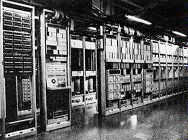
|
||

|
By the end of the "Showa 30's" (1955-1964), a comparison of analog "spatial division" and digital "time division" methods of selecting communication paths has determined that with the technology available at the time, the digital approach is practicable from a quality standpoint but is too costly to be attractive. Subsequent rapid gains in semiconductor technology enable dramatic reductions in cost and bring digital time-division type electronic exchange equipment into the real of feasibility. On-site testing at Tokyo's Karagasaki Telephone Exchange lead to the development of the D-60 digital exchange, which is first placed in service in the Otemachi Exchange in 1982. The D-60 exchange quickly becomes established as a relay exchange in the digitalization of intercity calling systems. | |

|
||